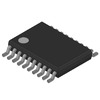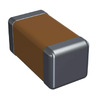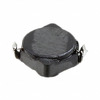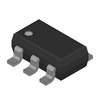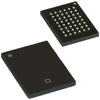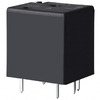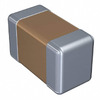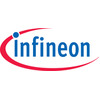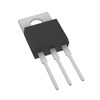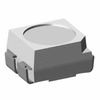TCS3200 RGB Color Sensor: Comparisons, Structure, and Applications
In this article, we delve into the TCS3200, a versatile device crafted to transform the hues of an object's surface into digital signals. The sensor's capacity to detect colors emerges from its capability to convert varying light intensities into frequency. The sensor's architecture excels in distinguishing subtle color differences, opening doors to numerous practical applications. We will explore its unique attributes, intricate design, and operational methods.
Catalog
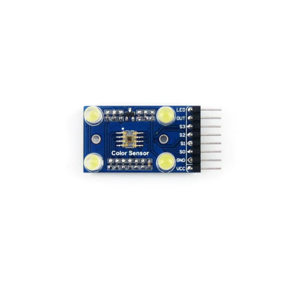
What is the TCS3200 Color Sensor?
The TCS3200, stands as an advanced, programmable RGB color sensor. It integrates silicon photodiodes, a current-to-frequency converter, and RGB filters, celebrated as the first of its kind to feature a digital interface. This adaptable sensor finds use in diverse applications, such as color measurement in printing, diagnostics, monitor calibration, and process control in sectors like textiles, cosmetics, and paints. Its capability to provide precise color data enriches these fields, where the representation of color can be deeply appreciated and profoundly impacting.
Replacements and Equivalents
• TCS230
• TCS3414
• TCS34725
What are the Features of the TCS3200 Sensor?
Interplay of Light and Signal Conversion
The TCS3200 sensor thoughtfully transforms fluctuating light intensities into precise square wave signals. With its adjustable gain, it gracefully adapts to varying lighting conditions, enhancing the subtleties of color detection. This flexibility finds its value in automated sorting systems, where lighting may shift unpredictably.
Operational Modes
Offering both frequency and pulse output modes, the sensor allows for nuanced signal processing. Based on specific application demands, users can choose the mode that harmonizes with their goals. Frequency mode might align with high-speed processing needs, while pulse mode offers sharper details amid changing ambient light.
CMOS Circuit Design
By blending the photodiode and frequency converter within one CMOS circuit, the sensor's architecture is streamlined, which may enhance efficiency and reduce signal degradation risks. This design philosophy mirrors a forward-thinking approach in sensor technology by minimizing complexity for more dependable operations.
Signal Frequency
The photodiode matrix configuration affords control over signal frequency, allowing precise adjustments tailored to specific requirements. This feature shines in color recognition tasks, where frequency accuracy can profoundly influence results.
High-Resolution Photodiode Array
Armed with a 16x4 photodiode array, the sensor boasts high resolution, skillfully distinguishing subtle color variations. This level of detail proves beneficial in quality control sectors, where identifying minor discrepancies supports the adherence to standards.
TCS3200 Pinout Footprint and Symbol Design

• Pins 1 & 2 (S0 & S1): Use these to choose the output frequency.
• Pin 3 (OE): Turn this on for frequency (it’s active low).
• Pin 4 (GND): Connect this pin to ground (0V).
• Pin 5 (VCC): This provides power to the sensor; it should be 5V.
• Pin 6 (OUT): This is where you get the output frequency.
• Pins 7 & 8 (S2 & S3): Use these to select the photodiode type.
TCS3200 Color Sensor Structure
The TCS3200 sensor incorporates a designed array that adeptly recognizes a spectrum of colors, opening a realm of possibilities for those who deeply engage with its features. This array comprises photodetectors responsive to red, green, and blue light, allowing the sensor to interpret and react to diverse color inputs with remarkable efficiency.
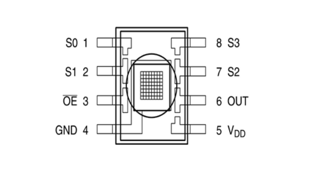
What are the Applications for the TCS3200 Color Sensor?
Medical Diagnostics
The sensor is instrumental in analyzing blood colors with precision. This detailed analysis aids in early anomaly detection. Practical applications include portable devices that deliver laboratory-level accuracy directly to point-of-care settings, enhancing efficiency and responsiveness during medical assessments.
Display and Imaging Technology
The TCS3200 use in color correction for monitors and cameras, ensuring precise color representation. In fields like professional photography and cinematography, where accurate color rendition holds right weight, it maintains consistency under varying lighting conditions, and supporting realism and quality.
Integration in IoT Systems
Within IoT systems, especially with Arduino, the sensor facilitates real-time color data acquisition. This capability allows smart environments to make dynamic adjustments, such as adaptive lighting systems that respond to ambient color shifts, optimizing energy use while enhancing user experience seamlessly.
Object Color Recognition
The sensor's ability to identify object colors extends to providing accurate RGB values. This is useful in inventory management systems, where precise product color recognition boosts organizational logistics. Such precision enhances the reliability of automation, streamlining operations effectively.
Environmental Monitoring
In environmental monitoring, the sensor assesses water quality and pollution levels by detecting color variations in water bodies. This serves as an early indicator of pollution, aiding conservation efforts. Implementing this technology in remote or underserved regions helps maintain ecological balance and protect public health.
Specifications of the TCS3200 Color Sensor
|
Product Attribute |
Attribute Value |
|
Manufacturer |
AMS |
|
Package / Case |
SOIC-8 |
|
Packaging |
Tape and Reel |
|
Part Status |
NRND |
|
Typical Supply Current |
1400 µA |
|
Typical Operating Supply Voltage |
5V |
|
Operating Temperature |
-40°C ~ 70 °C |
|
Pin Count |
8 |
|
Product Type |
Integrated Circuit |
Principle of Color Recognition
When you choose a color filter on the TCS3200 sensor, it only lets one primary color through and blocks the others. For example, with the red filter, only red light gets through while blue and green are blocked. By measuring the intensity of these three colors, we can determine the color of the light reflecting onto the sensor. The TCS3200 has four filters: red, green, blue, and clear. You can select the filter by adjusting the S2 and S3 pins.
|
S2 |
S3 |
PHOTODIODE TYPE |
|
L |
L |
Red |
|
L |
H |
Blue |
|
H |
L |
Clear (no filter) |
|
H |
H |
Green |
H means high level and L means low level. When light reflects off the test object and passes through filters to the TCS3200 sensor, it creates a square wave. The wave's frequency increases with the light's intensity, brighter light means a higher frequency. The sensor has an OUT pin that sends a signal linked to this frequency. You can adjust settings using pins SO and S1 to change the output. After processing the light, we need to do a white balance correction to find the RGB standard value for the color.
|
S0 |
S1 |
OUTPUT FREQUENCY SCALING
(f₀) |
|
L |
L |
Power down |
|
L |
H |
2% |
|
H |
L |
20% |
|
H |
H |
100% |
Color Detection Mechanism of the TCS3200
Initial Setup and Connections
To set up the TCS3200 sensor with the controller board, start by connecting VCC to 3.3V and GND to ground for a stable power supply. Next, link the OUT pin to a digital input on the controller. Use the S0, S1, S2, and S3 pins to configure the sensor modes. Finally, adjust S2 and S3 to activate specific functions, such as frequency measurement.
Configuring Operating Modes
Adjust S2 and S3 settings to select the sensor mode you want. This helps in sensing different color strengths. Keep an eye on the OUT pin's pulse for precise color readings. Getting the setup right required for trustworthy detection.
Capturing Color Data
Watch the OUT pin closely for signal changes to get accurate data, and use interrupts on the controller to detect changes in the sensor output. This method helps process color information in real-time, making it useful for quickly catching changes effectively.
Frequently Asked Questions [FAQ]
1. What is TCS3200 color sensor?
The TCS3200 combines photodiodes with a frequency converter on a CMOS chip. By producing a square wave that mirrors the intensity of detected light, it helps in tasks requiring accurate color differentiation, often employed in automated quality control systems.
2. What is the use of TCS3200?
This sensor captures a wide spectrum of colors, proving invaluable for projects centered on color recognition and sorting. Industries like recycling benefit from this functionality, where sorting materials by color enhances operational efficiency and precision.
3. What type of sensor is TCS3200?
Acting as a multi-purpose color detector, the TCS3200 integrates a TAOS RGB chip alongside LEDs, boosting its color detection performance. This arrangement proves beneficial in environments with variable lighting, supporting dependable color readings.
4. What is the difference between TCS3200 and TCS230?
While both sensors excel in color detection, the TCS230 is noted for its increased sensitivity and focus on narrower color bands with higher precision. This characteristic makes it apt for industries that demand exacting color detail, such as textiles.
5. How does the TCS3200 work?
Utilizing photodiodes on a CMOS chip, this sensor converts light to frequency, offering output proportional to light intensity. This mechanism is applied in devices like optical readers, dependent on precise color interpretation for optimal operation.
About us
ALLELCO LIMITED
Read more
Quick inquiry
Please send an inquiry, we will respond immediately.
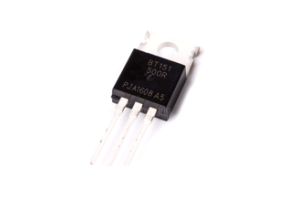
BT151 SCR Functionality: Features, Pin Configuration, and Applications
on September 26th

Understanding the Features and Functions of the TJA1043 CAN Transceiver
on September 26th
Popular Posts
-

What is GND in the circuit?
on January 1th 3271
-

RJ-45 Connector Guide: RJ-45 Connector Color Codes, Wiring Schemes, R-J45 Applications, RJ-45 Datasheets
on January 1th 2815
-

Understanding Power Supply Voltages in Electronics VCC, VDD, VEE, VSS, and GND
on November 20th 2635
-

Fiber Connector Types: SC Vs LC And LC Vs MTP
on January 1th 2265
-

Comparison Between DB9 and RS232
on January 1th 1882
-

What Is An LR44 Battery?
Electricity, that ubiquitous force, quietly permeates every aspect of our daily lives, from trivial gadgets to life-threatening medical equipment, it plays a silent role. However, truly grasping this energy, especially how to store and efficiently output it, is no easy task. It is against this background that this article will focus on a type of coin cell battery that may seem insignificant on the...on January 1th 1846
-

Understanding the Fundamentals:Inductance Resistance, andCapacitance
In the intricate dance of electrical engineering, a trio of fundamental elements takes center stage: inductance, resistance, and capacitance. Each bears unique traits that dictate the dynamic rhythms of electronic circuits. Here, we embark on a journey to decipher the complexities of these components, to uncover their distinct roles and practical uses within the vast electrical orchestra. Inductan...on January 1th 1806
-

What Is RF and Why Do We Use It?
Radio Frequency (RF) technology is a key part of modern wireless communication, enabling data transmission over long distances without physical connections. This article delves into the basics of RF, explaining how electromagnetic radiation (EMR) makes RF communication possible. We will explore the principles of EMR, the creation and control of RF signals, and their wide-ranging uses. The article ...on January 1th 1800
-

CR2430 Battery Comprehensive Guide: Specifications, Applications and Comparison to CR2032 Batteries
What is CR2430 battery ?Benefits of CR2430 BatteriesNormCR2430 Battery ApplicationsCR2430 EquivalentCR2430 VS CR2032Battery CR2430 SizeWhat to look for when buying the CR2430 and equivalentsData Sheet PDFFrequently Asked Questions Batteries are the heart of small electronic devices. Among the many types available, coin cells play a crucial role, commonly found in calculators, remote controls, and ...on January 1th 1797
-

Comprehensive guide to hFE in transistors
Transistors are crucial components in modern electronic devices, enabling signal amplification and control. This article delves into the knowledge surrounding hFE, including how to select a transistor's hFE value, how to find hFE, and the gain of different types of transistors. Through our exploration of hFE, we gain a deeper understanding of how transistors work and their role in electronic circu...on November 20th 1782

